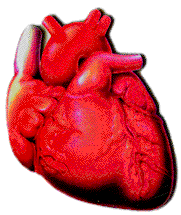- What is Arrhythmia
- Statistics on Arrhythmia
- Risk Factors for Arrhythmia
- Progression of Arrhythmia
- Symptoms of Arrhythmia
- Clinical Examination of Arrhythmia
- How is Arrhythmia Diagnosed?
- Prognosis of Arrhythmia
- How is Arrhythmia Treated?
- Arrhythmia References
What is Arrhythmia

Tachyarrhythmias include:
- Sinus tachycardia;
- Paroxysmal supraventricular tachycardia;
- Wolff-Parkinson-White syndrome;
- Atrial fibrillation;
- Atrial flutter;
- Ventricular ectopics;
- Ventricular tachycardia;
- Ventricular fibrillation.
Bradyarrhythmias include:
- Sinus bradycardia;
- Sick sinus syndrome;
- Heart block, which may be first, second or third degree.
Statistics on Arrhythmia
The occurance of arrhythmia is common; as many as 2.2 million Americans are living with atrial fibrillation (one type of arrhythmia). A recent study has also suggested that 1 in 4 Adult Americans over the age of 40 could develop an irregular heartbeat.
Risk Factors for Arrhythmia
- Heart disease (coronary artery disease): The coronary arteries are blood vessels that surround the heart and carry oxygenated blood to the hard-working heart muscle that is performing the pump function for itself and the rest of the body. Blood is also necessary to maintain a biologically sound electrical conduction system within the heart.
- Cardiac valvular disease: Deposits in the cardiac valves can also involve the heart wall between the 2 large pumping chambers – the ventricles. Without the unrestricted use of the valves, regular heart rate becomes difficult at best.
- Heart failure: Heart failure results in the inability of the heart to efficiently and consistently pump, causing excess fluid to collect in the legs and lung.
- Conductive tissue disease: A number of diseases can cause excessive amounts of substances to circulate in the bloodstream, including proteins and calcium. These substances may be deposited in different locations including the kidneys, connective tissue, and the specialized conducting tissues in the heart. When these deposits do form, the conducting tissue may become abnormal in turn affecting heartbeat.
- Ingested substances: Caffeine, tobacco, alcohol, cocaine, amphetamines, certain over-the-counter medications such as some cold medications, and prescribed medications may contribute to arrhythmia. Most of these substances act as artificial stimulants.
- Physical or psychological demands placed upon the heart due to exercise, fatigue and stress. These demands generate a cariety of hormones and stimulants which are common in people with irregular heartbeats.
Symptoms of Arrhythmia
Symptoms include:
- A sensation of feeling ones own heart beat (palpitations);
- Fainting;
- Light-headedness, dizziness;
- Chest pain;
- Shortness of breath;
- Paleness;
- Temporarily absence of ability to breath.
How is Arrhythmia Diagnosed?
- Blood tests may be done in an attempt to idenitfy the cause of the arrhythmia;
- ECG;
- Chest x-ray;
- Ambulatory cardiac monitoring;
- Echocardiogram.
Prognosis of Arrhythmia
The outcome is dependent on several factors:
- The form the arrhythmia takes;
- Whether it is an atrial arrhythmia (originating from the atrium) or a more dangerous arrhythmia such as ventricular tachycardia or ventricular fibrillation, which are potentially fatal;
- The overall pumping ability of the heart. In other words, the percentage of blood that the heart pumps from the ventricles to the body with each beat; and
- The individual patient’s health.
How is Arrhythmia Treated?
When an arrhythmia is serious, there may be insufficient bloodflow to the body’s vital organs, such as the brain, kidneys and the coronary arteries of the heart. When these cases exist, treatment is urgent and may include electrical “shock” (defibrillation or cardioversion), the implantation of a temporary pacemaker to interrupt the arrhythmia by making the heart beat faster (overdrive supression), or the immediate administration of intravenous medications.
For long-term treatment of arrhythmias, daily medications become part of everyday life. These include antiarrhythmic medications, medications to increase or decrease heart rate and others. Over the past decade, life-threatening arrhythmias have been increasingly treated with an implantable cardioverter-defibrillator (ICD). As soon as an arrhythmia begins, the ICD can detect it and send an automatic electrical shock to terminate it, or it can activate a pacemaker function to overdrive the arrhythmia.
Arrhythmia References
- Arrhythmia [online]. Dallas, TX: American Heart Association; 1998 [cited 15 September 2004]. Available from: URL link
- Arrhythmia [online]. Washington DC: American College of Cardiology; 2004 [cited 15 September 2004]. Available from: URL link
- Arrhythmias [online]. Omaha ,NE: eMedicine; 2004 [cited 15 September 2004]. Available from: URL link
Drugs/Products Used in the Treatment of This Disease:
- Adenocor (Adenosine)
- Cardinorm (Amiodarone hydrochloride)
- Chem mart Sotalol (Sotalol hydrochloride)
- Flecatab (Flecainide acetate)
- Kinidin Durules (Quinidine bisulfate)
- Lanoxin (Digoxin)
- Mexitil Capsules (Mexiletine hydrochloride)
- Persantin (Dipyridamole)
All content and media on the HealthEngine Blog is created and published online for informational purposes only. It is not intended to be a substitute for professional medical advice and should not be relied on as health or personal advice. Always seek the guidance of your doctor or other qualified health professional with any questions you may have regarding your health or a medical condition. Never disregard the advice of a medical professional, or delay in seeking it because of something you have read on this Website. If you think you may have a medical emergency, call your doctor, go to the nearest hospital emergency department, or call the emergency services immediately.







